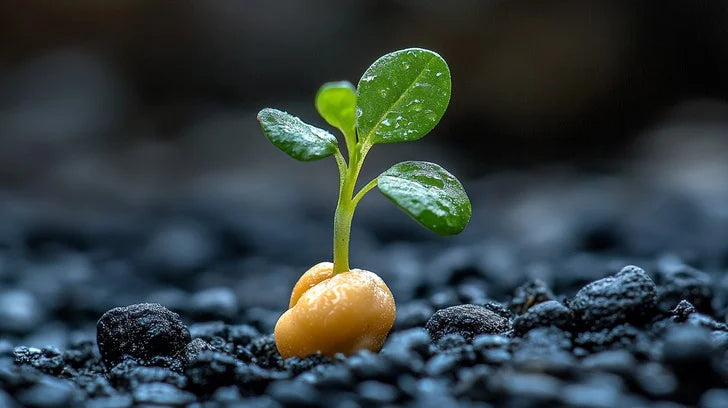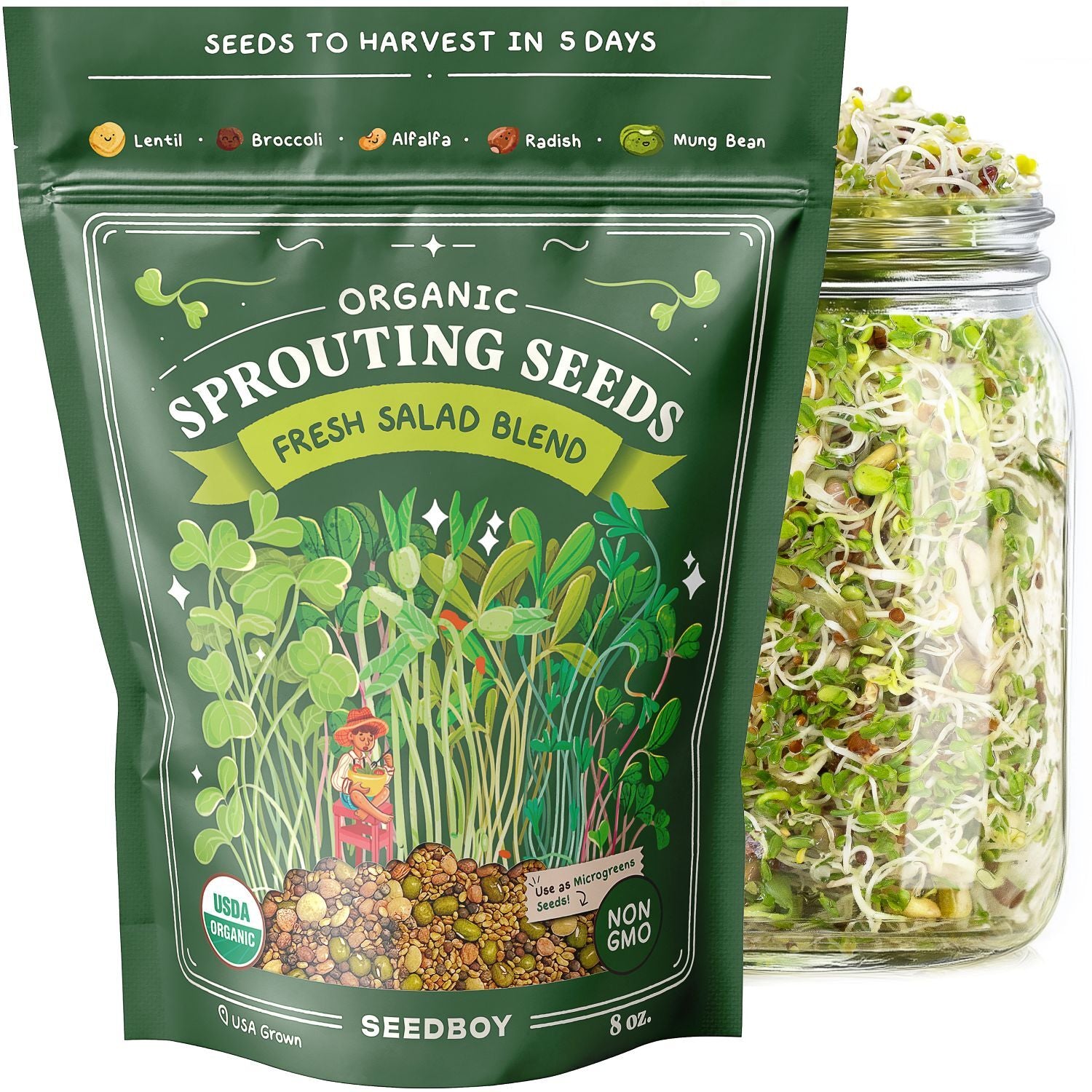
The Hidden Side of Sprouting: Why Some Seeds Thrive in Darkness First
Share
1. Light vs. Darkness: A Quick Overview
1.1 Germination Basics
- Germination is the process by which a seed transitions from dormancy to an active growing state.
- Moisture, temperature, and oxygen are key factors in triggering germination.
- Light requirements vary by seed type. Some seeds need light to germinate (e.g., lettuce), while others prefer darkness (e.g., some legumes and grains).
1.2 The Role of Photoreceptors
Seeds contain photoreceptors—proteins sensitive to light that help regulate growth. Depending on the species, these proteins can encourage or inhibit germination in the presence of light.
- Light-Required Seeds: Some seeds have photoreceptors that signal, “Now it’s time to grow,” upon detecting certain wavelengths of light.
- Light-Inhibited Seeds: Others remain dormant unless they’re shielded from light—darkness essentially “tells” these seeds they’re underground and safe to germinate.
2. Why Certain Sprouts Need Darkness
2.1 Mimicking Nature’s Underground Environment
Many seeds naturally germinate beneath the soil, away from sunlight. In an artificial sprouting environment—like a jar or tray—replicating that dark, moist setting can prompt them to sprout more quickly and uniformly.
2.2 Conserving Energy for Initial Growth
In darkness, seeds focus on root and shoot development rather than producing chlorophyll (the green pigment in plants). By not expending energy on photosynthesis in the earliest stages, the seed can allocate more resources to developing robust roots and strong sprouts.
2.3 Flavor and Texture Advantages
- Flavor: Darkness-grown sprouts often have a milder, sweeter taste because they aren’t yet producing as many bitter compounds associated with photosynthesis.
- Texture: Sprouts developed in the dark can be more tender and elongated, which some people prefer for specific dishes—especially in cuisines that prize softer bean sprouts.
3. Examples of Sprouts That Benefit from Darkness
-
Bean Sprouts (Mung, Soy, Adzuki)
- In many Asian culinary traditions, bean sprouts are kept under dark conditions for a crunchy yet slightly sweet result.
-
Pea Shoots (Depending on the Growth Stage)
- While pea shoots eventually require light for greening, an initial dark period can help elongate their stems.
-
Wheatgrass (Before It Greens)
- Wheat seeds often benefit from a brief dark phase to set roots, after which they’re placed in light to develop chlorophyll.
(Note: “Darkness” doesn’t mean pitch black 24/7 for days on end. It typically means partial shade or a covered tray for the first 1–2 days before introducing some light.)
4. The Dark-Sprouting Method: Step by Step
-
Soak Your Seeds
- Rinse the seeds and soak them in cool water as recommended (6–8 hours for most types, although larger beans may require up to 12 hours).
- Proper soaking hydrates the seed and starts the germination process.
-
Drain and Rinse
- After soaking, drain off all the water. Rinse the seeds thoroughly to remove any debris or excess starch.
-
Cover or Shade
- Transfer the seeds into your sprouting container (a jar with a mesh lid, a tray, or even a specialty sprouter).
- Place them in a dark or partially shaded area. If you’re using a jar, you can cover it with a towel or store it in a cupboard. If you’re using a tray, a lid or another tray on top can simulate the darkness.
-
Maintain Moisture
- Rinse the seeds 2–3 times daily, ensuring the container is well-drained afterward.
- Overly wet seeds can lead to mold growth, so proper drainage is key.
-
Observe Growth
- Over the first couple of days, the seeds will begin to sprout small roots. Look for signs that the sprouts are elongating (especially with bean seeds) without turning slimy or mushy.
-
Introduce Light Gradually
- After 2–3 days of darkness (or once sprouts reach the desired length), expose them to indirect sunlight.
- This final step encourages chlorophyll production, turning your sprouts a vibrant green if that’s what you want. Alternatively, keep some or all of them in partial darkness for milder-tasting, paler sprouts if that’s your preference.
5. Culinary Tips for Dark-Grown Sprouts
-
Stir-Fries & Asian-Style Dishes
- Bean sprouts developed in darkness are often the go-to for quick wok stir-fries, soup add-ins, and spring roll fillings. They’re crunchy, juicy, and subtly sweet.
-
Salad Textures
- Dark-grown sprouts can lend a softer, juicier mouthfeel to salads compared to sun-exposed varieties, which might taste more herbal or “grassy.”
-
Aesthetic Choices
- Some cooks prefer the pale, nearly translucent look of dark-grown sprouts for plating, especially in minimalist or high-end presentations. The stark contrast against bright vegetables can be visually stunning.
-
Mix and Match
- Grow half your seeds in darkness longer for a paler, sweeter result, and let the other half get more light for a greener, more robust flavor. Combine them in a single dish for complexity in both appearance and taste.
6. Common Pitfalls to Avoid
-
Overwatering
- Dark conditions plus excess moisture can be a magnet for mold. Remember to drain thoroughly after each rinse.
-
Poor Airflow
- Even in darkness, airflow matters. If covering your sprouts, make sure it’s not an airtight seal.
-
Skipping the Light Phase Entirely
- Some sprouts do well staying in near-darkness throughout their growing cycle (like mung bean sprouts), but others will need at least partial exposure to light eventually. Be aware of each seed type’s specific needs.
-
Harvest Timing
- If you wait too long to introduce light, sprouts can become leggy or overly fibrous. Monitor daily to find the sweet spot for texture.
7. Final Thoughts
While we often associate plant growth with sunshine, the sprouting process can be more nuanced. Many seeds actually flourish in a darker environment for the first couple of days—allowing them to develop robust roots, conserve energy, and create a milder flavor profile. By understanding which seeds prefer a head start in the dark and tailoring your sprouting routine accordingly, you can unlock new textures, tastes, and nutritional benefits.
Key Takeaways
- Dark sprouting mimics natural underground conditions, promoting strong, uniform growth.
- The flavor, texture, and appearance of certain sprouts (especially bean sprouts) improve when they begin life in lower light.
- Proper rinsing and airflow are crucial to prevent mold in dark, damp environments.
- Experimentation is your friend: test different degrees of darkness and exposure to find your ideal sprout flavor and look.
By harnessing the power of darkness—and then selectively introducing light—you can cultivate sprouts with a wide range of textures, tastes, and visual appeal. It’s a simple, rewarding way to elevate your home sprouting to professional-quality results.
